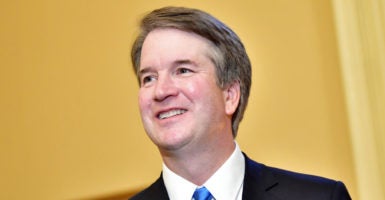From the moment President Donald Trump nominated Judge Brett Kavanaugh to fill Justice Anthony Kennedy’s Supreme Court seat, gun control advocates have presented a seemingly endless string of accusations about Kavanaugh’s “dangerous views” on the Second Amendment.
Taken together, the denunciations of his jurisprudence spell out a parade of horribles that make the judge appear primed to personally hand out grenade launchers to preschoolers.
Shannon Watts, founder of the gun control group Moms Demand Action, criticized Kavanaugh’s interpretation of the Second Amendment as “extreme and dangerous” because it “does not take into account the law’s impact on public safety.”
Similarly, Dennis Henigan, the former vice president of the Brady Center to Prevent Gun Violence, complained that Kavanaugh did not allow his interpretation of constitutional protections to be swayed by “newly emerging threats of violence” or the support of new data.
These dramatic and uninformed condemnations reveal much less about Kavanaugh’s jurisprudence than they do about the struggle between the left’s vision of an activist judiciary and the Framers’ vision of governance, which emphasizes a judiciary that plays an important but limited role and leaves policymaking to Congress.
Where the left wants a “living Constitution” that allows unelected judges to dictate policy and flexibly expand or retract the scope and meaning of constitutional rights at will—often as a means of sidestepping the broad consensus intentionally required for constitutional amendments—a good judge instead defers to the original meaning of the Constitution and faithfully applies that meaning without infusing his personal preferences into the matter.
As evidence that Kavanaugh despises gun control laws and will do whatever it takes to expand the rights of gun owners (in the same way they would expect a liberal judge to find some way of making the Constitution fit his or her preferred policy), these gun control advocates universally point to his dissenting opinion in Heller v. District of Columbia (2011), often referred to as Heller II because of its status as a follow-up to the landmark 2008 decision between the same parties (Heller I).
In Heller I, the Supreme Court affirmed the original understanding of the Second Amendment at the time of its ratification (and, arguably, for the first 150 years thereafter) by declaring that it protects an individual right to keep and bear arms, irrespective of that individual’s membership in a militia.
While the Second Amendment right—like all other rights—is not unlimited, any restrictions on the right must be found in the text and in the surrounding history and traditions of the right.
The Supreme Court in Heller I declined to specify where these limits fall in a modern context, but did state unequivocally that the Second Amendment protects the rights of law-abiding citizens to keep and bear those arms that are commonly used for lawful purposes. This meant that handguns—by far the most popular firearm chosen by citizens for lawful purposes—could not be categorically banned, despite the fact that they raise significant public safety concerns as the firearm of choice for criminals.
Meanwhile, Heller II involved a challenge to the District of Columbia’s efforts to continue imposing severe gun control restrictions on residents in the wake of Heller I. In particular, the plaintiff in Heller II questioned the constitutionality of both the District of Columbia’s categorical prohibition of semi-automatic “assault” rifles and its requirement that all firearms be registered with the D.C. police.
Despite the Supreme Court’s clear holding in Heller I that the Second Amendment protects the right of law-abiding citizens to keep and bear those firearms commonly used for lawful purposes, and that the scope of the amendment’s protections is not subject to balancing tests to weigh the costs and benefits of the underlying public policy, the D.C. Circuit upheld the restrictions as constitutional under Heller I.
The majority did so by invoking the public safety implications of semi-automatic rifles and by insisting that the Second Amendment right wasn’t really burdened by the ban because residents could still use handguns.
Kavanaugh dissented, reasoning that “D.C.’s public safety motivation in enacting these [gun restrictions] is worthy of great respect. But the means D.C. has chosen are … constitutionally problematic.”
He reminded his brethren on the D.C. Circuit that “our task as a lower court here is narrow and constrained by precedent. We need not squint to divine some hidden meaning from Heller I about what tests to apply. Heller I was up-front about the role of text, history, and tradition in Second Amendment analysis—and about the absence of a role for judicial interest balancing or assessment of costs and benefits of gun regulations.”
Kavanaugh reasoned that semi-automatic rifles, unlike automatic “machine guns,” have been considered lawful for civilian possession for over 100 years, and are commonly owned by law-abiding citizens today. In fact, the Supreme Court already stated in the 1994 case of Staples v. United States that semi-automatic firearms (and in that particular case, the AR-15) “traditionally have been widely accepted as lawful possession[s].” Their recent prohibition by a handful of jurisdictions is therefore, according to Kavanaugh, not rooted in history and tradition, as required by Heller I.
He also correctly noted the majority’s flawed logic regarding the public safety implications of semi-automatic rifles. Even if the majority assumed that Heller I permitted interest balancing or the assessment of costs and benefits of particular gun regulations, how could the prohibition of semi-automatic rifles be constitutional under a cost-benefit analysis when the prohibition of handguns—which are used in the vast majority of gun-related crimes and therefore present a much greater risk to the public—is constitutionally forbidden?
Unlike the majority, Kavanaugh refrained from illogically twisting precedent to validate his preferred public policy. He explained that his “view on how to analyze the constitutional question here under relevant Supreme Court precedents is not to say that I think certain gun registration laws or laws regulating semi-automatic guns are necessarily a bad idea as a matter of policy.”
Instead, he clarified that “our task is to apply the Constitution and the precedents of the Supreme Court, regardless of whether the result is one we agree with as a matter of first principles or policy.”
The main takeaway from Kavanaugh’s Heller II dissent is not that he is an extremist or that he personally dislikes the idea of regulating semi-automatic rifles. It is, rather, that he faithfully applied binding precedent during his time on the D.C. Circuit, in spite of whatever his personal policy preferences might have been.
In fact, neither we nor anyone else really know Kavanaugh’s personal thoughts on firearms. While he suggests it’s possible that he may agree with the District of Columbia that certain gun control policies are good ideas, he ultimately rests his analysis solely on a logical, fair, and thorough analysis of Heller I. And this, truly, reflects well on Kavanaugh’s understanding of the role of the judiciary.
Perhaps more than anything, it’s this very reality—that Kavanaugh’s personal views are irrelevant to his judicial philosophy—that irks the left into fantastical accusations about him. Unfortunately, this also makes their denunciations of his “extremist views” nothing more than denunciations of the “extremist” protections originally guaranteed by the Bill of Rights, and of the “extremist” philosophy that judges should not infuse the Constitution with their own preferences.
We, for one, hope that Kavanaugh personally appreciates the fundamental importance of an armed citizenry capable of defending itself against both crime and tyranny. But ultimately, as he himself repeatedly affirmed throughout his 12 years on the bench, he is intent on interpreting and applying the enduring principles of the Constitution as its Framers and ratifiers understood them—not as he thinks they would be better understood today.
































